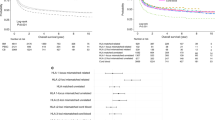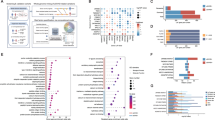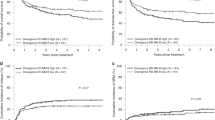Abstract
The results of unrelated donor transplantation (URD-BMT) are difficult to analyze since the continuous advances in HLA typing technology allow the detection of new mismatches unknown at the time of transplantation. We sought to confirm that matched recipient–donor pairs are in fact often mismatched when advanced HLA typing techniques are used. We retrospectively studied the impact of the results of high resolution HLA typing for HLA class I (-A, -B, -C) and HLA class II (-DR, -DQ, -DP) loci, and cytotoxic T lymphocyte precursor (CTLp) frequency, on the outcome of 69 URD-BMT procedures. At the time of transplant, six (6/69) and two (2/69) donor–recipient pairs were mismatched for HLA classI (-A and -B by serology) and HLA class II, respectively, while one pair was mismatched for both HLA class I and II. Using high resolution DNA typing, HLA class I mismatches were found in 31 (45%) pairs and HLA class II mismatches in nine (13%) pairs. Twenty-three of the 69 pairs were HLA-C mismatched. Low CTLp frequencies were found among the 19 HLA class I matched pairs tested, and also in 5/14 mismatched pairs (of whom three had severe aGVHD). The overall survival of the cohort was 28 ± 6%. Among the 33 patients who were fully matched with their donors, the survival rate was 66% in the 18 patients with a standard hematological risk and 9% in the 15 high risk patients. Only two of the 33 patients developed severe aGVHD, and only one had graft rejection. Among the 36 mismatched pairs, the survival rate was 31% in the 13 patients with a standard hematological risk and 8% in the 23 high risk patients. Sixteen of these 36 patients died from severe aGVHD and four had graft failure or rejection. Three of the 10 patients with only an HLA-C mismatch died from severe aGVHD, and two had graft rejection. In conclusion: (1) donor–recipient matching based on high resolution HLA class I and II DNA typing is associated with significantly better outcome after URD-BMT; (2) the results of URD-BMT with classical GVHD prevention are comparable to those of geno-identical BMT when donor and recipient are fully matched for HLA-A, -B, -C, -DRB1 and -DQB1 on the basis of high resolution typing; (3) CTLp frequencies do not correlate constantly with HLA class I matching, and our results fail to show that CTLp assay can distinguish between permissable and non-permissable class I mismatches; (4) clinical trials involving donor–recipient pairs with known HLA class I mismatches are needed to improve aGVHD prevention without increasing graft failure rate. Bone Marrow Transplantation (2001) 27, 35–43.
This is a preview of subscription content, access via your institution
Access options
Subscribe to this journal
Receive 12 print issues and online access
$259.00 per year
only $21.58 per issue
Buy this article
- Purchase on SpringerLink
- Instant access to full article PDF
Prices may be subject to local taxes which are calculated during checkout





Similar content being viewed by others
References
Petersdorf EW, Longton GM, Anasetti C et al. The significance of the HLA-DRB1 matching on clinical outcome after HLA-A, B, DR identical unrelated bone marrow transplantation Blood 1995 86: 1606–1613
Spencer A, Szydlo RM, Brookes PA et al. Bone marrow transplantation for chronic myeloid leukemia with volunteer unrelated donors using ex vivo or in vivo T-cell depletion: major prognosis impact of HLA class I identity between donor and recipient Blood 1995 86: 3590–3597
Anasetti C, Beatty PG, Storb R et al. Effect of HLA incompatibility on graft-versus-host disease, relapse, and survival after marrow transplantation for patients with leukemia or lymphoma Hum Immunol 1989 29: 79–97
Ash RC, Casper JT, Chitamber CR et al. Successful allogeneic transplantation of T-cell-depleted bone marrow from closely HLA-matched unrelated donors New Engl J Med 1990 322: 485–494
Hansen JA, Gooley TA, Martin PJ et al. Bone marrow transplants from unrelated donors for patients with chronic myeloid leukemia New Engl J Med 1998 338: 962–968
DeVergie A, Apperley JF, Labopin M et al. European results of matched unrelated donor bone marrow transplantation for chronic myeloid leukemia. Impact of HLA class II matching. Chronic Leukemia Group for Blood and Marrow Transplantation Bone Marrow Transplant 1997 20: 11–19
Dini G, Lamparelli T, Rondelli R et al. Unrelated donor marrow transplantation for chronic myelogenous leukemia Br J Haematol 1998 102: 544–552
Speiser DE, Tiercy JM; Rufer N et al. High resolution HLA matching associated with decreased mortality after unrelated bone marrow transplantation Blood 1996 87: 4455–4462
Sasazuki T, Juji T, Morishima Y et al. Effect of matching of class I HLA alleles on clinical outcome after transplantation of hematopoietic stem cells from an unrelated donor New Engl J Med 1998 339: 1177–1185
Petersdorf EW, Gooley TA, Anasetti C et al. Optimizing outcome after unrelated marrow transplantation by comprehensive matching of HLA class I and II alleles in the donor and recipient Blood 1998 92: 3515–3520
Scott I, O'Shea J, Bunce M et al. Molecular typing shows a high level of HLA class I incompatibility in serologically well matched donor/patient pairs: implications for unrelated bone marrow donor selection Blood 1998 92: 4864–4871
Prasad VK, Kernan NA, Heller G et al. DNA typing for HLA-A and HLA-B identifies disparities between patients and unrelated donors matched by HLA-A and HLA-B serology and HLA-DRB1 Blood 1999 93: 399–409
Mason PM, Parham P . HLA class I region sequences Tissue Antigens 1998 51: 417–466
Scott I, Bunce M, Brookes P et al. The role of cellular and molecular class I HLA typing in selection of unrelated bone marrow donors Exp Hematol 1995 23: 744–747
Bunce M, Barnardo MC, Procter J et al. High resolution HLA-C typing by PCR-SSP: identification of allelic frequencies and linkage disequilibria in 604 unrelated random UK caucasoids and a comparison with serology Tissue Antigens 1996 48: 680–691
Grundschober C, Rufer N, Sanchez Mazas A et al. Molecular characterization of HLA-C incompatibilities in HLA-ABDR-matched unrelated bone marrow donor–recipient pairs Tissue Antigens 1997 49: 612–623
Kaminski E, Sharroch C, Hows J et al. Frequency analysis of cytotoxic T lymphocyte precursors: possible relevance to HLA-matched unrelated donor bone marrow transplantation Bone Marrow Transplant 1988 3: 149–155
Storb R, Deeg HJ, Appelbaum F et al. Methotrexate and cyclosporine compared with cyclosporine alone for prophylaxis of acute graft versus host disease after marrow transplantation for leukemia New Engl J Med 1986 314: 729–735
Glucksberg H, Storb R, Fefer A et al. Clinical manifestations of graft-versus-host disease in human recipients of marrow from HLA-matched sibling donors Transplantation 1974 18: 295–304
Mittal KK, Mickey MR, Singal DP, Terasaki PI . Serotyping for hemotransplantation. Refinement of microdroplet lymphocyte cytotoxicity test Transplantation 1968 3: 913–927
Mercier B, Al Daccack R, Samaan A et al. HLA-DRB1 and -DQB1 typing by PCR amplification using sequence-specific primers (PCR-SSP): assessment after 1 year of routine use by three laboratories Eur J Immunogenet 1994 21: 105–123
Mercier B, Ferec C, Dufosee F, Huart JJ . Improvement in the HLA-DQB1 typing by PCR-RFLP: introduction of constant restriction sites in one of the primers as digestion verifies Tissue Antigens 1992 40: 86–89
Christiansen FT, Witt CS, Dawkins RL . Questions in marrow matching: the implications of ancestral haplotypes for routine practice Bone Marrow Transplant 1991 8: 83–86
Petersdorf EW, Longton GM, Anasetti C et al. Association of HLA-C disparity with graft failure after marrow transplantation from unrelated donors Blood 1997 89: 1818–1823
Colonaa M, Spies T, Strominger JL et al. Alloantigen recognition by two human natural killer cell clones is associated with HLA-C or closely linked gene Proc Natl Acad Sci USA 1992 89: 7983–7985
Lanier LL, Gumperz JE, Parham P et al. The NKB1 and HP3E4 NK cell receptors are structurally distinct glycoproteins and independently recognize polymorphic HLA-B and HLA-C molecules J Immunol 1995 154: 3320–3327
Author information
Authors and Affiliations
Rights and permissions
About this article
Cite this article
El Kassar, N., Legouvello, S., Joseph, C. et al. High resolution HLA class I and II typing and CTLp frequency in unrelated donor transplantation: a single-institution retrospective study of 69 BMTs. Bone Marrow Transplant 27, 35–43 (2001). https://doi.org/10.1038/sj.bmt.1702733
Received:
Accepted:
Published:
Issue date:
DOI: https://doi.org/10.1038/sj.bmt.1702733
Keywords
This article is cited by
-
HLA genotyping by next-generation sequencing of complementary DNA
BMC Genomics (2017)
-
Unrelated donor marrow transplantation in children: transplant policy and outcome in Leiden Paediatrics SCT-Centre
Bone Marrow Transplantation (2010)
-
Impact of HLA matching on outcome of hematopoietic stem cell transplantation in children with inherited diseases: a single-center comparative analysis of genoidentical, haploidentical or unrelated donors
Bone Marrow Transplantation (2004)
-
Alloreactive killer cells: hindrance and help for haematopoietic transplants
Nature Reviews Immunology (2003)
-
The degree of matching at HLA-DPB1 predicts for acute graft-versus-host disease and disease relapse following haematopoietic stem cell transplantation
Bone Marrow Transplantation (2003)



